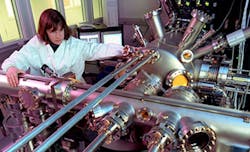ADELPHI, Md. (Jan. 11, 2018) – Scientists at the U.S. Army Research Laboratory (ARL; Adelphi, MD) and Stony Brook University (Stony Brook, NY) have developed a new synthesis process for low-cost fabrication of a material previously discounted in literature for high-sensitivity infrared cameras—the semiconductor indium arsenide antimonide (InAsSb).1 The research can potentially aid future Army night-time operations.
InAsSb has not been used before in high-performance IR cameras for the longest wavelengths of around 10 µm. The best materials for the IR camera light-sensors are currently based on mercury cadmium telluride (HgCdTe), which belongs to the family of II-VI semiconductor compounds. "Unfortunately, they are very expensive, mostly because there are only military customers for this material," Svensson says Stefan Svensson, one of the ARL researchers.
No strain distortion
InAsSb is a III-V semiconductor, which is a class of materials used in optoelectronics in many commercial products such as DVD players and cell phones. The key in the discovery was the realization that the material needed to be undistorted by strain in order to see at 10 µm. InAsSb has to be deposited onto a starting crystalline substrate with a smaller lattice spacing; his size mismatch at the atomic scale must be managed extremely well in order for the light-sensitive material to work properly.
Among possible substrates, larger and cheaper ones typically have progressively smaller atomic spacing. Over several years ARL and Stony Brook found a way to manage the atomic spacing mismatch culminating in the current work, which uses gallium arsenide (GaAs) as a substrate. This is the most common substrate used in the III-V industry for numerous consumer products. It is inexpensive and available in large sizes. Large-area substrates allow manufacturing of multiple camera sensors at the same time, which could be done in commercial foundries.
ARL and Stony Brook combined strain-mediating techniques to effectively manage the ~10% atomic spacing mismatch between the InAsSb sensing material and GaAs substrate. To do this, they deposited an intermediate layer of GaSb onto GaAs in a way that trapped most of the defects caused by the size mismatch. They then further increased the atomic spacing with a graded layer that also kept defects away from the InAsSb sensor material.
So lower-cost night-vision systems based on III-V long wavelength IR materials could be in the Army's future.
The work at Stony Brook was funded by the Army Research Office.
Source: https://www.arl.army.mil/www/default.cfm?article=3140
REFERENCE:
1. W. L. Sarney et al., Journal of Applied Physics 122, 025705 (2017); https://doi.org/10.1063/1.4993454.

